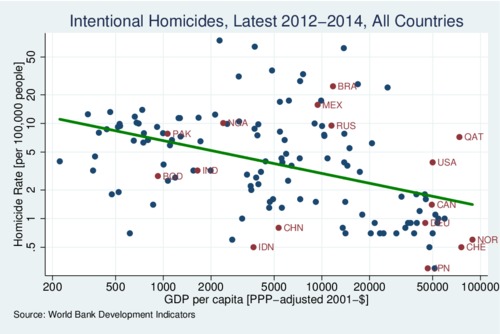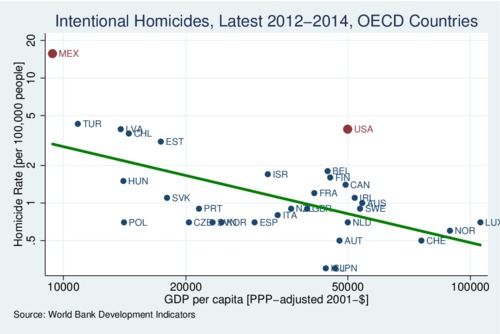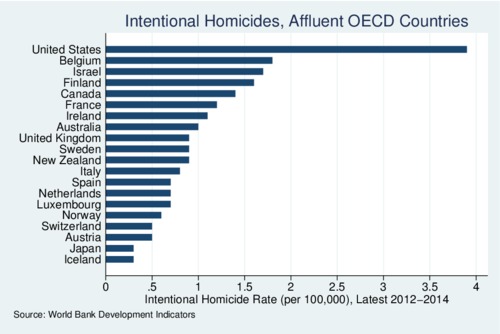Endemic gun violence in the United States became too visible again in the mass shooting in Las Vegas on Sunday. The regularity with which these tragedies are unfolding in the United States is shocking. When even the senseless murder of twenty children in the 2012 Sandy Hook Elementary School shooting was not enough to shake up the lawmakers in Congress, what will? It is almost certain that the members of Congress who are beholden to the gun lobby will fall silent again ("now is not the time to talk about gun control") and pretend that nothing is wrong with gun laws in the United Sates. As Steve Israel put it in the New York Times eloquently, Nothing Will Change After the Las Vegas Shooting. Canadians cannot stand silent on this matter: four of the people killed in Las Vegas were Canadian visitors. A Globe and Mail editorial on October 4 described it as: "The wrong thing to do would be to throw up our hands and say, Evil exists, so there's nothing we can do."
Even if the U.S. remains espoused to its Second Amendment rights, there is a big difference between laissez-faire gun ownership and responsible gun ownership. Even the wildest gun enthusiast in the U.S. should realize that civilians do not need automatic weapons—and this ought to include semi-automatic weapons that can be modified with (legal) add-ons into quasi-automatic weapons, as happened in Las Vegas. With the election of the Trump administration, it is even less likely that anything will happen to curb gun violence south of the border. In comparison to Canada, the homicide and gun violence rate in the United States is astoundingly high. Yet, there are some in the United States who argue that the high rate of gun violence is nothing exceptional in international comparisons. They are wrong, and here is the empirical justification why they are wrong. Sadly, the U.S. is a case of exceptionalism when it comes to gun violence.
Gun advocates argue that the United States is nowhere near the top of the list of countries with high homicide rates. Technically, that statement is correct. I have looked at the intentional homicide rates per 100,000 people reported in the World Development Indicators. Using the latest available year (2014, in some cases a year or two earlier), the United States ranks 85th out of 166. Honduras tops the list with 74.6 homicides per 100,000 people, an astounding 19 times higher than in the United States, and 53 times higher than in Canada. El Salvador, Venezuela, Jamaica, and South Africa are, sadly, not far behind Honduras. Yet, the comparison with the U.S. is inappropriate. It is necessary to control for the stage of social development and the sophistication of legal institutions. Economists routinely use per-capita GDP to proxy for these.
The World Bank data on intentional homicides includes all methods of murder, by gun or otherwise. On the other hand, the intentional homicide rate under-report deaths attributable to guns, because such deaths include accidents and suicides. The diagram below is a double-logarithmic plot of homicide rates against per-capita GDP. There is a strong negative relationship. As countries grow richer and develop better institutions (including policing), murder rates fall dramatically. Keep in mind that the vertical scale is logarithmic and distances show proportions, not levels. Countries with a population of less than one million were excluded, as well as countries with rates of 0.2 or less (due to rounding, these numbers may be less accurate).
The green regression line suggests that as countries develop from the very left to the very right of the diagram, murder rates drop by a factor of ten—an order of magnitude. Yet, there is much scattering even when controlling for income. Countries such as China and Indonesia have low murder rates, while richer Brazil, Mexico, and Russia have enormously high murder rates. Among the very rich countries, most have very low rates (Norway, Switzerland, Japan). Only Quatar (with a population of 2 million) and the United States stand out as countries clearly above the green line.

click on image for high-resolution PDF image
‘The argument that gun violence in the U.S. is nothing exceptional by international standards is demonstrably false after controlling for the level of socio-economic development.’
Looking at the above diagram, it may appear that the U.S. is not all that special with a high homicide rate. That impression is false, because the comparison needs to focus on countries of similar social and economic development. Let us therefore focus on the appropriate peer group of OECD countries, mostly affluent countries, and open societies and democracies. Among these countries there remains a strong negative relationship between per-capita GDP and homicide rates. Yet, there are two outliers that hover far above the green line: Mexico on the left, and the United States on the right (shown in red). Both countries have significant problems with gun violence, for different reasons. So here it becomes clear that the United States are special compared to its peers.
A technical note on the two regressions. The estimated elasticities in the two diagrams are –0.34 for all countries and –0.77 for the OECD countries. Both coefficients are highly significant statistically. The R-squares are 0.19 and 0.32, respectively.

click on image for high-resolution PDF image
On the left of the above diagram we still find a good number of countries with relatively poor economies. Let us move one step further and limit the peer group to countries that are at least half as rich as the United States as measured by GDP per capita. Arguably, the poorer countries among the OECD members have significantly weaker institutions. Then rank the remaining countries in descending order. The United States appears, sadly, at the very top of the list, far ahead of all others when shown on a linear scale. The homicide rate in the United States is roughly three times as large as in Canada, four times as large as in Germany, and nearly eight times as large as in Switzerland.

click on image for high-resolution PDF image
The argument that gun violence in the United States is nothing exceptional by international standards is demonstrably false after controlling for the level of socio-economic development. Or do the pundits in the U.S. who point to other countries really want to compare the U.S. with Russia, Brazil, and Mexico? The U.S. has a big problem, but no sense of urge to deal with it. The hyper-partisan gun lobby has much to answer for the failure of legislators to enact measures to ensure responsible gun ownership, but its actions are only part of the picture. The bigger problem is that many Americans have deluded themselves into thinking that gun ownership protects them from crime, and that gun ownership is the essential and indispensable guarantee of freedom and liberty. Gun ownership in the United States has morphed into a quasi-religion, and no amount of scientific evidence is allowed to dispute the tenet of unrestricted gun ownership.
As mentioned earlier, the numbers shown in the table above mask a large part of the actual gun violence. Intentional homicides are only one part of the total number of gun deaths, which are about 10.5 per 100,000 (and includes suicides and accidents) rather than the 3.9 shown in the diagram (which includes murder by other means than guns). The rate of gun homicides per 100,000 is about 3.4. In 2014, about 33,600 people lost their lives due to gun violence in the United States (gunpolicy.org). If the U.S. was more like Canada, that number would drop by 27,000!
So what are sensible policies to curb gun violence in the United States? We know what responsible ownership looks like. We exercise this responsibility for motor vehicles. Drivers get trained and licensed. Vehicles are registered and insured to cover liability. Police patrol our streets to ensure compliance with our traffic rules. Grave offenders lose their driver's license or have their vehicle impounded for some time. Operators of special vehicles require special training and licenses. Vehicles are equipped with safety features such as seat belts and air bags and infant seats. Vehicles are parked in ventilated garages to prevent fumes from entering buildings. We don't let our kids drive cars, and we keep the keys in a safe place. And we collect taxes on motor fuels to cover other negative externalities. Translate all of that one by one to gun ownership. Now, if politicians in Washington were truly concerned about the welfare of their constituents, they would act. Those who don't are morally complicit in the deaths of the innocent victims of gun violence. They put allegiance to a powerful lobby group, or their fealty to the tenets of their quasi-religion, over the welfare of the citizens they are elected to represent.
Canada's gun laws are mostly sensbile, but not perfect either. There are clear categories for "non-restricted", "restricted", and "prohibited" firearms, and the latter two require registrations. Individuals need to obtain a firearms license before they can purchase a gun, or keep one in possession. Applicants have to complete a safety training course and pass security screening. There is a 28-day waiting period for first-time applicants. Non-restriced firearms include hunting rifles and shotguns, while virtually all handguns are restricted. Unfortunately, the lax laws in the U.S. have implications for Canada, as illegal weapons are smuggled across the border (see the Washington Post article Canadians crack down on guns, alarmed by flow from U.S., February 2016), or are brought across by US visitors who are woefully ignorant of Canadian law (see Macleans magazinze Americans trying to bring guns into Canada with 'alarming frequency', August 2017). The RCMP reports that the illicit firearms market in Canada is supplied primarily by smuggled firearms, particularly handguns, from the United States. Our Canadian homicide rate could be lower than it is today, if it wasn't for the fact that easy availability of handguns in the United trickles across our border. The federal government in Ottawa is promising to take sensible steps to enhance responsible gun ownership in Canada, and crack down on gun smuggling into Canada. Perhaps the best that Canadians can do is to show our southern neighbour that there is a better way when it comes to gun onwership, a way that puts safety first.
Further readings:
- Global Study on Homicide, United Nations Office on Drugs and Crime, 2013.
![[Sauder School of Business]](logo-ubc-sauder-2016.png)
![[The University of British Columbia]](logo-ubc-2016.png)